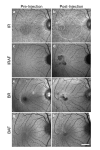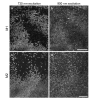Cellular-scale evaluation of induced photoreceptor degeneration in the living primate eye
- PMID: 30775083
- PMCID: PMC6363191
- DOI: 10.1364/BOE.10.000066
Cellular-scale evaluation of induced photoreceptor degeneration in the living primate eye
Abstract
Progress is needed in developing animal models of photoreceptor degeneration and evaluating such models with longitudinal, noninvasive techniques. We employ confocal scanning laser ophthalmoscopy, optical coherence tomography (OCT) and high-resolution retinal imaging to noninvasively observe the retina of non-human primates with induced photoreceptor degeneration. Photoreceptors were imaged at the single-cell scale in three modalities of adaptive optics scanning light ophthalmoscopy: traditional confocal reflectance, indicative of waveguiding; a non-confocal offset aperture technique visualizing scattered light; and two-photon excited fluorescence, the time-varying signal of which, at 730 nm excitation, is representative of visual cycle function. Assessment of photoreceptor structure and function using these imaging modalities revealed a reduction in retinoid production in cone photoreceptor outer segments while inner segments appeared to remain present. Histology of one retina confirmed loss of outer segments and the presence of intact inner segments. This unique combination of imaging modalities can provide essential, clinically-relevant information on both the structural integrity and function of photoreceptors to not only validate models of photoreceptor degeneration but potentially evaluate the efficacy of future cell and gene-based therapies for vision restoration.
Conflict of interest statement
DRW: University of Rochester (P).
Figures








References
-
- von Helmholtz H., Beschreibung eines Augen-Spiegels zur Untersuchung der Netzhaut im lebenden Auge (A Förstner'sche Verlagsbuchhandlung, Berlin, Germany, 1851).
Grants and funding
LinkOut - more resources
Full Text Sources
